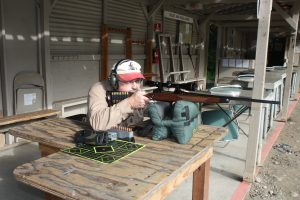By Dave Workman | Senior Editor

Dave Workman has already zeroed his hunting rifles, including this Savage in .308 Winchester, for this fall’s deer season. Use a good sandbag rest, take your time and you should be able to zero any rifle with less than a half-box of cartridges.
Big game seasons are still over the horizon, but time’s a-wasting if you have a new rifle and/or scope, and it needs to be properly sighted-in long before you head for camp.
There is a fast way to zero a hunting rifle. It doesn’t involve complicated formulas, just a little time and two targets, one set at 25 yards and the other at 100 yards.
You’ll need a sandbag, or maybe a couple of sandbags, and about a half-box of ammunition, the same loads you will use in the field this fall. You will also need a pair of binoculars and/or a spotting scope.
With your rifle steadied on the sandbags, aim at the bullseye at 25 yards and fire one round only. Open the action, let the chamber and barrel cool while you look at where the bullet strikes.
Let’s say your bullet punches a hole three inches low and two inches to the left. Chamber a second cartridge and aim again at the 25-yard bullseye. If the bullet strikes at the same place—and expect it to be close if not in the same ragged hole—crack open the action and do some figuring.
A typical riflescope will shift the point of impact ¼-inch at 100 yards for each click, up or down, side to side. At 100 yards, four clicks will move the point of impact one inch.
However, at 25 yards, you need to rotate your adjustment knobs four clicks to move the impact point a quarter-inch, and 16 clicks to move that bullet an inch up or down, left or right.
So, sticking to the scenario of three inches low and two inches to the left, you will need to click your vertical knob 48 clicks up and 32 clicks right, to put your third shot into the bullseye at 25 yards. Load one round and fire. There should be a nice hole in the X-ring.
This formula has worked for me for many years, with many different rifles and scopes.
Fire a fourth shot to confirm, then open the action and shift your attention to the 100-yard target. Once the chamber and barrel have cooled down, load a fifth round, and if you’re using a variable-power scope, crank it up to the highest magnification, steady the crosshairs on the “X” and press the trigger. Expect the bullet to be off a bit, high or low, right or left.
This is when you make the final adjustments. Say the bullet strikes an inch high and a half-inch to the right. If you want to zero at 100 yards, just crank down 1-inch (four clicks) and two clicks back left. The next shot should be dead-on. Taking into account the “human factor,” I might just turn the elevation down three clicks (3/4-inch) and one click left (1/4-inch) and with a bullet striking that close, you’re not likely to leave something standing in the brush!
However, say you’re going to be hunting where shots will be at 200 or more yards. Allowing for bullet drop, you will want to raise the impact point at 100 yards maybe two inches, depending upon the caliber of rifle and the muzzle velocity of your rounds. Often you can find the advertised velocity printed on the cartridge box.
My hunting rifles are all zeroed to shoot 2.5 to 3 inches high at 100 yards, which puts them on the mark at 225-250 yards, or so close that it will make no difference to the game I’m shooting, taking into account my bullet’s weight and velocity. Having punched several deer through the ticker at better than 200 yards with three different rifles, and plonking one nice Snake River buck at 350 yards with a single shot from my .30-06 by holding high on the flank just behind the shoulder, I think the formula works reliably.
Three years ago, I zeroed my brother’s bolt-action Ruger in .308 Win. and was able to break a clay target at 200 yards from a cold barrel. A month later, he anchored a nice buck with an uphill shot at about 150 yards.
Let the rifle cool and run an oily patch down the bore, followed by a dry patch. Being a firm believer in the “fouling shot,” a couple of days before the opener I’ll stop by the range and fire a single round through each of the rifles I intend to use during the season.



